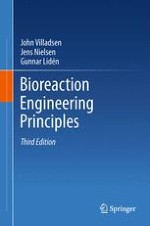2011 | OriginalPaper | Chapter
8. Population Balance Equations
Authors : John Villadsen, Jens Nielsen, Gunnar Lidén
Published in: Bioreaction Engineering Principles
Publisher: Springer US
Activate our intelligent search to find suitable subject content or patents.
Select sections of text to find matching patents with Artificial Intelligence. powered by
Select sections of text to find additional relevant content using AI-assisted search. powered by
